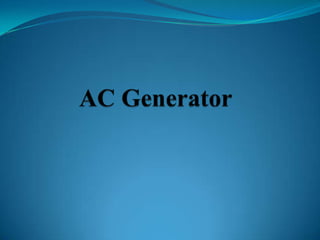
F:\Ac Generator Ppt
- 1. AC Generator
- 4. b. Armature
- 6. d. Rotor
- 7. e. Stator
- 12. The rotor is driven by the generator’s prime mover, which may be a steam turbine, gas turbine, or diesel engine.
- 13. Depending on the type of generator, this component may be the armature or the field.
- 16. Like the rotor, this component may be the armature or the field, depending on the type of generator.
- 18. The slip ring consists of a circular conducting material that is connected to the rotor windings and insulated from the shaft.
- 19. Brushes ride on the slip ring as the rotor rotates.
- 20. The electrical connection to the rotor is made by connections to the brushes.
- 22. This is not necessary for an AC generator.
- 23. Therefore, an AC generator may use slip rings, which will allow the output current and voltage to oscillate through positive and negative values.
- 26. The field coil in the rotor receives excitation through the use of slip rings and brushes.
- 27. Two brushes are spring-held in contact with the slip rings to provide the continuous connection between the field coil and the external excitation circuit.
- 29. A generator has many turns of wire wound into the slots of the rotor.
- 30. The magnitude of AC voltage generated by an AC generator is dependent on the field strength and speed of the rotor.
- 32. Figure 3: Simple AC Generator
- 33. The frequency of the generated voltage is dependent on the number of field poles and the speed at which the generator is operated, as indicated in Equation . f = NP/120 where: f = frequency (Hz) P = total number of poles N = rotor speed (rpm) 120 = conversion from minutes to seconds and from poles to pole pairs The 120 in Equation is derived by multiplying the following conversion factors. 60 seconds x 2 poles 1 minute pole pair In this manner, the units of frequency (hertz or cycles/sec.) are derived.
- 34. Losses in an AC Generator
- 36. The combination of these make up what is known as the internal resistance, which causes a loss in an AC generator.
- 37. When the load current flows, a voltage drop is developed across the internal resistance.
- 40. The magnetic domains of the cores are held in alignment with the field in varying numbers, dependent upon field strength.
- 41. The magnetic domains rotate, with respect to the domains not held in alignment, one complete turn during each rotation of the rotor.
- 43. After the heat-treated silicon steel is formed to the desired shape, the laminations are heated to a dull red and then allowed to cool.
- 44. This process, known as annealing, reduces hysteresis losses to a very low value.
- 46. Careful maintenance can be instrumental in keeping bearing friction to a minimum.
- 47. Clean bearings and proper lubrication are essential to the reduction of bearing friction.
- 48. Brush friction is reduced by ensuring: proper brush seating, proper brush use, and maintenance of proper brush tension.
- 49. A smooth and clean commutator also aids in the reduction of brush friction.
- 53. Solution: In order to calculate efficiency, the input and output power must be in the same units. As described in Thermodynamics, the horsepower and the watt are equivalent units of power.Input Power = 5 hp x 746W hp=3730 W Output Power = 2 kW =2000 W Efficiency =(output/input)x100= (2000 W /3730 W)= 0.54 x 100 =54%
- 56. (2) serial number and type number;
- 57. (3) speed (rpm), number of poles, frequency of output, number of phases, and maximum supply voltage;
- 58. (4) capacity rating in KVA and kW at a specified power factor and maximum output voltage;
- 59. (5) armature and field current per phase; and
- 60. (6) maximum temperature rise. Power (kW) ratings of an AC generator are based on the ability of the prime mover to overcome generator losses and the ability of the machine to dissipate the internally generated heat. The current rating of an AC generator is based on the insulation rating of the machine.
- 61. Figure 4 AC Generator Nameplate Ratings
- 65. This arrangement is called a rotating field, stationary armature AC generator. The rotating field, stationary armature type AC generator is used when large power generation is involved.
- 66. In this type of generator, a DC source is supplied to the rotating field coils, which produces a magnetic field around the rotating element.
- 68. Figure 6: Simple AC Generator - Rotating Field, Stationary Armature
- 70. Physically adjacent loops (Figure 7) are separated by 60° of rotation; however, the loops are connected to the slip rings in such a manner that there are 120 electrical degrees between phases.
- 73. In actual practice, the windings are connected together, and only three leads are brought out and connected to the external load.
- 74. Two means are available to connect the three armature windings.
- 77. Figure 9 : Characteristics of a Delta-Connected Generator
- 80. This is called a wye connection (Y) (Figure 10).
- 81. The voltage and current characteristics of the wye-connected AC generator are opposite to that of the delta connection.
- 82. Voltage between any two lines in a wye- connected AC generator is 1.73 (or ) 3 times any one phase voltage, while line currents are equal to phase currents.
- 84. Figure 11: Characteristics of a Wye-Connected AC Generator
- 85. An advantage of a wye-connected AC generator is that each phase only has to carry 57.7% of line voltage and, therefore, can be used for high voltage generation.